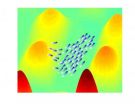(Press-News.org) LIVERMORE, Calif. -- In order to separate human-caused global warming from the "noise" of purely natural climate fluctuations, temperature records must be at least 17 years long, according to climate scientists.
To address criticism of the reliability of thermometer records of surface warming, Lawrence Livermore National Laboratory scientists analyzed satellite measurements of the temperature of the lower troposphere (the region of the atmosphere from the surface to roughly five miles above) and saw a clear signal of human-induced warming of the planet.
Satellite measurements of atmospheric temperature are made with microwave radiometers, and are completely independent of surface thermometer measurements. The satellite data indicate that the lower troposphere has warmed by roughly 0.9 degrees Fahrenheit since the beginning of satellite temperature records in 1979. This increase is entirely consistent with the warming of Earth's surface estimated from thermometer records.
Recently, a number of global warming critics have focused attention on the behavior of Earth's temperature since 1998. They have argued that there has been little or no warming over the last 10 to 12 years, and that computer models of the climate system are not capable of simulating such short "hiatus periods" when models are run with human-caused changes in greenhouse gases.
"Looking at a single, noisy 10-year period is cherry picking, and does not provide reliable information about the presence or absence of human effects on climate said Benjamin Santer, a climate scientist and lead author on an article in the Nov. 17 online edition of the Journal of Geophysical Research (Atmospheres).
Many scientific studies have identified a human "fingerprint" in observations of surface and lower tropospheric temperature changes. These detection and attribution studies look at long, multi-decade observational temperature records. Shorter periods generally have small signal to noise ratios, making it difficult to identify an anthropogenic signal with high statistical confidence, Santer said.
"In fingerprinting, we analyze longer, multi-decadal temperature records, and we beat down the large year-to-year temperature variability caused by purely natural phenomena (like El Niños and La Niñas). This makes it easier to identify a slowly-emerging signal arising from gradual, human-caused changes in atmospheric levels of greenhouse gases," Santer said.
The LLNL-led research shows that climate models can and do simulate short, 10- to 12-year "hiatus periods" with minimal warming, even when the models are run with historical increases in greenhouse gases and sulfate aerosol particles. They find that tropospheric temperature records must be at least 17 years long to discriminate between internal climate noise and the signal of human-caused changes in the chemical composition of the atmosphere.
"One individual short-term trend doesn't tell you much about long-term climate change," Santer said. "A single decade of observational temperature data is inadequate for identifying a slowly evolving human-caused warming signal. In both the satellite observations and in computer models, short, 10-year tropospheric temperature trends are strongly influenced by the large noise of year-to-year climate variability."
###
The research team is made up of Santer and Livermore colleagues Charles Doutriaux, Peter Caldwell, Peter Gleckler, Detelina Ivanova, and Karl Taylor, and includes collaborators from Remote Sensing Systems, the National Center for Atmospheric Research, the University of Colorado, the Canadian Centre for Climate Modeling and Analysis, the National Oceanic and Atmospheric Administration, the U.K. Meteorology Office Hadley Centre, and Lawrence Berkeley National Laboratory.
Founded in 1952, Lawrence Livermore National Laboratory (http://www.llnl.gov) provides solutions to our nation's most important national security challenges through innovative science, engineering and technology. Lawrence Livermore National Laboratory is managed by Lawrence Livermore National Security, LLC for the U.S. Department of Energy's National Nuclear Security Administration.
Separating signal and noise in climate warming
2011-11-21
ELSE PRESS RELEASES FROM THIS DATE:
In an enzyme critical for life, X-ray emission cracks mystery atom
2011-11-21
ITHACA, N.Y. - Like a shadowy character just hidden from view, a mystery atom in the middle of a complex enzyme called nitrogenase had long hindered scientists' ability to study the enzyme fully.
But now an international team of scientists led by Serena DeBeer, Cornell assistant professor of chemistry and chemical biology, has pulled back the curtain using powerful synchrotron spectroscopy and computational modeling to reveal carbon as the once-elusive atom.
The research was published online Nov. 17 in the journal Science.
"For chemists, one of the first steps you ...
Environmental conditions and predators affect Atlantic salmon survival in the Gulf of Maine
2011-11-21
Stocks of Atlantic salmon (Salmo salar), which have been steadily declining for the past few decades, are facing new challenges in the Gulf of Maine, where changing spring wind patterns, warming sea surface temperatures and new predators along altered migration routes are affecting their survival.
In a paper published online in the journal Fisheries Management and Ecology, Kevin Friedland and co-authors suggest post-smolts are entering an increasingly warmer coastal ocean, where they are facing mortality risks associated with a changing climate, such as changing distributions ...
Researchers discover new way to form extracellular vesicles
2011-11-21
Researchers at NYU Langone Medical Center have discovered a protein called TAT-5 that affects the production of extracellular vesicles, small sacs of membrane released from the surface of cells, capable of sending signals to other cells. When released extracellular vesicles can affect tumor spread, blood clotting and inflammation. Their discovery gives new insight into how extracellular vesicles form, and reveals new potential strategies to manipulate diseases such as cancer. The study was published online November 17, 2011 in Current Biology.
"Very little is known ...
Micro-cavity arrays: Lighting the way to the future
2011-11-21
It was not too long ago that basic science lectures began with the three forms of matter: gases, liquids and solids—and somewhere along the line plasmas were occasionally added to the list. But to be precise, a plasma is an ionized gas; thus, a subset of the big three. But this subset has coexisted with the other forms since the Big Bang and actually makes up 99 percent of the universe. It is found in our Sun and all the other stars, and in more down to earth applications: in neon signs, Plasma TVs, Cathode Ray Tubes, and the ubiquitous fluorescent light.
It is now ...
Bleak future for Bay area tidal marshes?
2011-11-21
[San Francisco, CA] – A new study, led by PRBO Conservation Science (PRBO), projects a bleak future for San Francisco Bay's tidal marshes under high-end sea-level rise scenarios that are increasingly likely. PRBO and colleagues found that in the worst case scenario 93% of San Francisco Bay's tidal marsh could be lost in the next 50-100 years [with 5.4 feet or 1.65 meters of sea-level rise, low sediment availability and no significant restoration].
PRBO's study indicates, however, that not all marshes will be lost and that society's actions today, including restoration ...
Smart swarms of bacteria inspire robotics researchers
2011-11-21
Much to humans' chagrin, bacteria have superior survival skills. Their decision-making processes and collective behaviors allow them to thrive and even spread efficiently in difficult environments.
Now researchers at Tel Aviv University have developed a computational model that better explains how bacteria move in a swarm — and this model can be applied to man-made technologies, including computers, artificial intelligence, and robotics. Ph.D. student Adi Shklarsh — with her supervisor Prof. Eshel Ben-Jacob of TAU's Sackler School of Physics and Astronomy, Gil Ariel ...
Targeting bacterial gas defenses allow for increased efficacy of numerous antibiotics
2011-11-21
Although scientists have known for centuries that many bacteria produce hydrogen sulfide (H2S) it was thought to be simply a toxic by-product of cellular activity. Now, researchers at NYU School of Medicine have discovered H2S in fact plays a major role in protecting bacteria from the effects of numerous different antibiotics.
In the study led by Evgeny Nudler, PhD, the Julie Wilson Anderson Professor of Biochemistry at NYU School of Medicine, researchers found evidence that H2S acts as a general defense mechanism against oxidative stress, the process through which ...
NASA's Chandra adds to black hole birth announcement
2011-11-21
New details about the birth of a famous black hole that took place millions of years ago have been uncovered, thanks to a team of scientists who used data from NASA's Chandra X-ray Observatory as well as from radio, optical and other X-ray telescopes.
Over three decades ago, Stephen Hawking placed -- and eventually lost – a bet against the existence of a black hole in Cygnus X-1. Today, astronomers are confident the Cygnus X-1 system contains a black hole, and with these latest studies they have remarkably precise values of its mass, spin, and distance from Earth. With ...
VLBA observations key to 'complete description' of black hole
2011-11-21
For the first time, astronomers have produced a complete description of a black hole, a concentration of mass so dense that not even light can escape its powerful gravitational pull. Their precise measurements have allowed them to reconstruct the history of the object from its birth some six million years ago.
Using several telescopes, both ground-based and in orbit, the scientists unravelled longstanding mysteries about the object called Cygnus X-1, a famous binary-star system discovered to be strongly emitting X-rays nearly a half-century ago. The system consists of ...
Study of flower petals shows evolution at the cellular level
2011-11-21
A new study of flower petals shows evolution in action, and contradicts more that 60 years of scientific thought.
The findings are reported by a scientist from UC Santa Barbara and a research team from Harvard University in the Proceedings of the Royal Society B this week.
Columbine flowers, known as Aquilegia, evolved several lengths of petal spurs that match the tongue lengths of their pollinators, including bees, hummingbirds, and hawkmoths. The petal spurs are shaped like a tubular pocket and contain nectar at the tip. The spurs grow from 1 to 16 centimeters in ...



